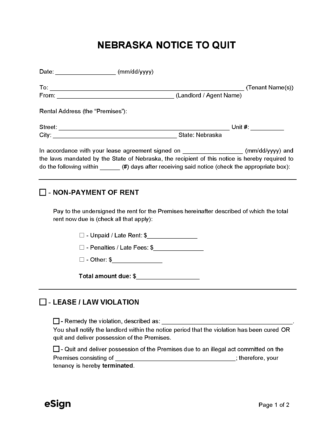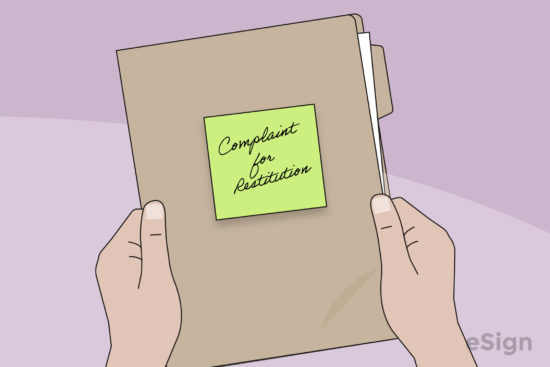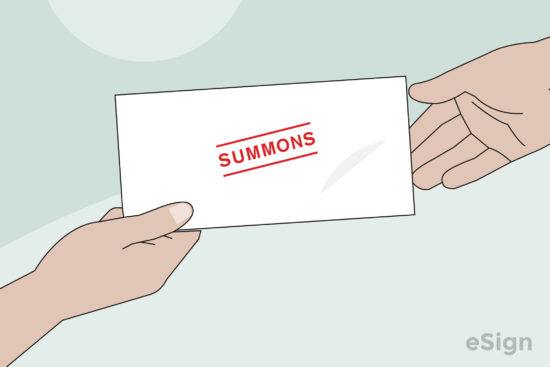Eviction Notices: By Type (4)
 7-Day Notice to Quit | Non-Payment – Served on tenants who fail to pay rent on time. 7-Day Notice to Quit | Non-Payment – Served on tenants who fail to pay rent on time.
Download: PDF, Word (.docx), OpenDocument |
14/30-Day Notice to Quit | Non-Compliance – Informs a tenant that they are in violation of their lease terms or state statutes. – Informs a tenant that they are in violation of their lease terms or state statutes.
Download: PDF, Word (.docx), OpenDocument |
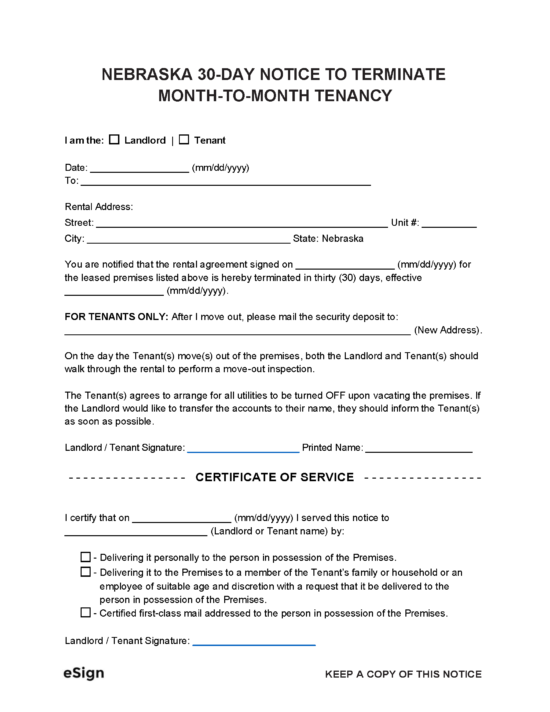 30-Day Notice to Terminate Month-to-Month Tenancy – Used by either the landlord or tenant to terminate a month-to-month lease with 30 days’ notice. 30-Day Notice to Terminate Month-to-Month Tenancy – Used by either the landlord or tenant to terminate a month-to-month lease with 30 days’ notice.
Download: PDF, Word (.docx), OpenDocument |
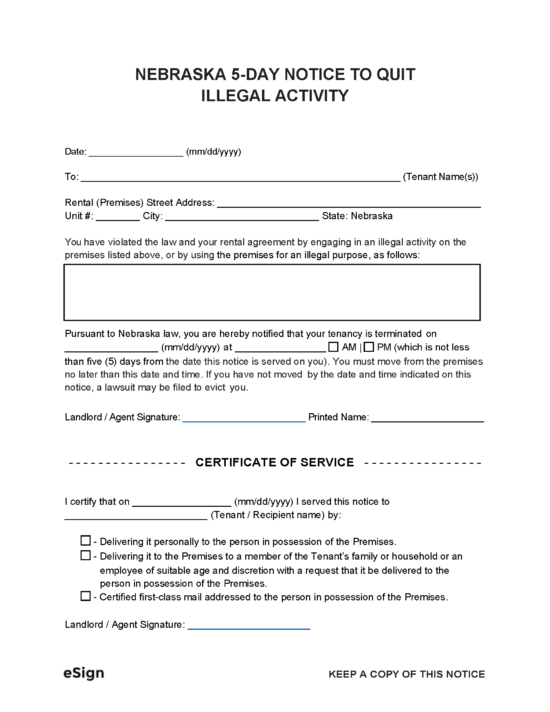 5-Day Notice to Quit | Illegal Activity – Used when a tenant engages in or allows illegal activity on the premises. 5-Day Notice to Quit | Illegal Activity – Used when a tenant engages in or allows illegal activity on the premises.
Download: PDF, Word (.docx), OpenDocument |
Notice Requirements
How to Evict a Tenant in Nebraska
Step 1 – Complete Eviction Notice
Before filing an eviction lawsuit against the tenant, the landlord must draft a written notice giving the tenant a certain number of days to leave the property (or fix the issue, if applicable).
Step 2 – Deliver Notice to Tenant
The notice can be hand-delivered to the tenant, posted on the premises, or served by the sheriff’s office. State law doesn’t require a specific method of delivery.
Step 3 – File Complaint for Restitution
If the tenant doesn’t comply with the notice terms within the given time frame, the landlord can file a Complaint for Restitution with the county court. For cases where the landlord’s damages exceed $57,000, the Complaint must be filed with the district court.
Once the complaint is processed, the court will issue a Summons form, which will serve as a notice of the upcoming eviction hearing.
Step 4 – Service of Summons and Complaint
The court will arrange for the sheriff or constable to serve the Summons and Complaint on the tenant by handing it to them in person or posting it on the tenant’s door with a second copy sent by mail. The Summons will relay the date and place of the eviction hearing.
If the tenant wishes to contest the case, they can file an Answer with the court with a copy mailed to the landlord or give their response at the trial.
Step 5 – Attend Eviction Trial
Both the landlord and tenant must appear in court for the eviction trial. If either person is absent, the court may rule in favor of whoever is present.
If the court rules in favor of the landlord, the tenant will be forced to vacate within a specific number of days. If the tenant wins, they can keep their lease.
Step 6 – Serve Writ of Restitution on Tenant
Following the landlord’s victory in court, a Writ of Restitution may be requested, which authorizes the sheriff’s department to remove the tenant from the property within 10 days.
To obtain a Writ of Restitution, the landlord must file a Praecipe for a Writ of Restitution/Execution with the court. The sheriff’s department will then serve the form on the tenant.
Step 7 – Reclaim Possession of the Premises
If the tenant still hasn’t moved out, the sheriff’s department will visit the premises on the date stated in the Writ of Restitution and force them to vacate the property.
Court Forms + Resources
Forms
- Answer and General Denial
- Signed by: Tenant
- Complaint for Restitution
- Signed by: N/A
- Summons
- Signed by: N/A
- Praecipe for Writ of Restitution/Execution (CC 3:24)
- Signed by: Landlord
- Writ of Restitution
- Signed by: N/A
Resources
